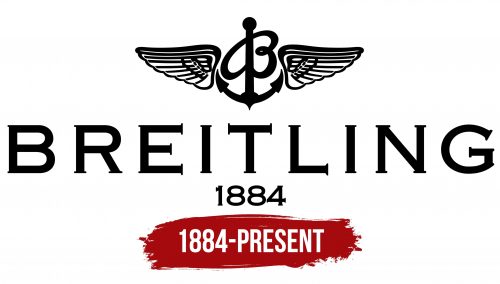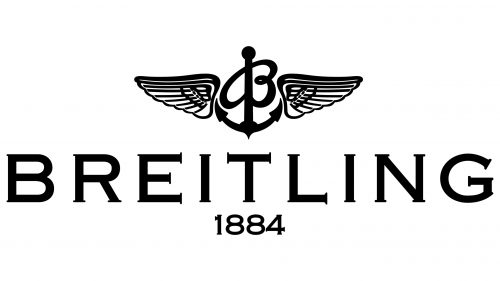The Breitling logo embodies a harmonious combination of stability, utmost precision, and elegance. Every detail is important in creating a cohesive and well-balanced composition that reflects the brand’s high standard. Clear lines and carefully designed elements form an image that symbolizes centuries-old traditions of craftsmanship and the consistent quality that the brand has deservedly enjoyed for over a hundred years.
Breitling: Brand overview
Breitling’s history began in 1884 when Leon Breitling, a young and talented watchmaker, established his workshop in the small Swiss canton of Saint-Imier. Born in 1860, Leon was fascinated with watches and mechanics from an early age. His passion for innovation and precision became the foundation of the company’s future philosophy.
In its early years, Breitling’s workshop focused on producing high-precision chronometers and chronographs. Leon quickly gained a reputation as a master of complex and reliable measuring instruments. His designs were admired for accuracy and elegance, attracting attention from experts and discerning watch enthusiasts alike.
In 1892, Leon Breitling moved his workshop to La Chaux-de-Fonds, the center of Swiss watchmaking. This relocation allowed the business to increase production and strengthen its position in the industry. The company began specializing in clocks during this period, eventually becoming the brand’s hallmark.
A major milestone occurred in 1914. Leon’s son, Gaston, who had become actively involved in the family business, created the world’s first independent push-button chronograph mechanism. This advancement allowed the chronograph function to operate separately from the main watch mechanism, greatly enhancing accuracy and ease of use.
In 1915, the brand introduced the first wristwatch featuring a separate chronograph button at the two o’clock position. Military pilots quickly adopted this invention as a practical and reliable tool for tracking time in flight.
In 1923, the company made another breakthrough by developing a mechanism that separated the chronograph’s start, stop, and reset functions. This innovation allowed users to measure multiple consecutive time intervals without resetting the clock. After Gaston’s passing in 1932, his son Willy took over the business. Under his leadership, the company continued refining its expertise in aviation timepieces. In 1936, the British Royal Air Force began using its official chronographs.
The iconic Chronomat model was introduced in the 1940s. With its built-in circular slide rule, this watch became an essential tool for engineers and pilots. With its launch in 1942, pilots gained the ability to perform complex calculations directly on the watch while in the air.
1952, the company unveiled one of its most famous models, the Navitimer. Featuring an onboard aviation computer, the Navitimer became highly popular with professional pilots and aviation enthusiasts. The watch enabled navigation-related calculations such as distance, average speed, climb time, and fuel consumption.
In the 1960s, the brand expanded into new realms. In 1962, astronaut Scott Carpenter wore a specially adapted Navitimer while piloting the Aurora 7 spacecraft. The Cosmonaute model became the first Swiss wristwatch used in space.
In 1969, the company and other Swiss watchmakers introduced the Chrono-Matic caliber, the first automatic chronograph with a micro-rotor. This development marked a major advancement in the watch industry.
Due to the rise of quartz watches, the 1970s and 1980s were challenging years for the business and the Swiss watch industry. However, Ernest Schneider acquired the company in 1978 and successfully preserved and strengthened its reputation. Under the Schneider family’s leadership, it continued to innovate. In 1985, the Aerospace model, featuring both analog and digital displays, was introduced and quickly adopted by professional pilots for its reliability and practicality.
Mechanical watches regained popularity in the 1990s. The company responded by expanding its classic collections and introducing new models such as the Emergency, the first watch with a built-in emergency radio beacon.
In the early 2000s, the watchmaker became a leader in high-precision chronometers. In 2009, the company launched its in-house movement, the B01 caliber, designed and produced entirely within its factory.
A major change occurred in 2017 when CVC Capital Partners, an investment firm, acquired most of the company. Despite the ownership shift, it remained committed to its heritage of innovation and tradition.
The company continued releasing new models and updating its classic collections in the following years. It actively fostered partnerships with other brands, reinforcing its reputation as a maker of timepieces suited to professionals across various industries. By 2023, the brand had established itself as one of the leading luxury watchmakers, recognized for its dedication to innovation, precision, and style. Over its 130-year history, the company has consistently been defined by its pursuit of watchmaking excellence.
Meaning and History
What is Breitling?
This Swiss watchmaker has carved out a unique niche in the industry with its aviation watches. The brand has become synonymous with technical excellence and the spirit of adventure, earning a reputation for making reliable, accurate, and functional timepieces. Pilots, astronauts, and diving specialists have worn its iconic large clocks for years, often equipped with slide rule bezels. The commitment to precision and reliability has led to collaborations with aviation associations and military forces worldwide. In addition to aviation watches, the brand produces diving watches and even smartwatches while maintaining bold, appealing designs and superior technical specifications that have become its hallmark.
1884 – today
The emblem of the Swiss brand Breitling represents reliability and precision. An anchor is at the core of the logo, symbolizing permanence and stability. Wings are added on the sides, conveying the passage of time, creating a composition that can be interpreted as “reliability through time.” Given that the brand specialized in producing chronographs, the choice of imagery was fitting.
The calligraphic capital letter “B” elegantly wraps around the anchor, pointing to the brand. This letter reflects grace and refinement, highlighting the sophisticated style of Breitling’s designs. The detailed depiction of small accents symbolizes a meticulous approach and attention to every detail in the production process.
Below the image is the brand name, taken from the founder’s surname—Léon Breitling. Large, solid letters with rectangular serifs perfectly complement the anchor, giving the entire composition a sense of stability and firmness. This inscription symbolically guarantees the reliable operation of mechanisms for decades.
The year the company was founded—1884—is at the bottom of the logo. However, it is worth noting that the brand’s modern history began in 1979 when Ernst Schneider acquired the rights to Breitling and revived production at his factory.





